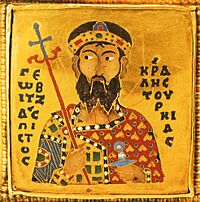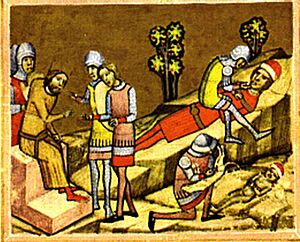Coloman, King of Hungary facts for kids
Quick facts for kids Coloman the Learned |
|
|---|---|
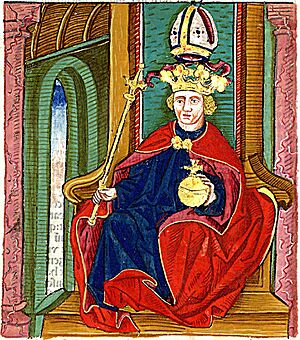
Coloman depicted in János Thuróczy's Chronicle of the Hungarians
|
|
| King of Hungary | |
| Reign | 1096 – 3 February 1116 |
| Coronation | spring of 1096, Székesfehérvár |
| Predecessor | Ladislaus I |
| Successor | Stephen II |
| King of Croatia | |
| Reign | 1097 – 3 February 1116 |
| Coronation | 1102, Biograd |
| Predecessor | Petar Snačić |
| Successor | Stephen II |
| Born | c. 1070 |
| Died | 3 February 1116 (aged 45–46) |
| Burial | Székesfehérvár Basilica |
| Spouse | Felicia of Sicily Eufemia of Kiev |
| Issue more... |
Sophia Stephen II of Hungary |
| Dynasty | Árpád dynasty |
| Father | Géza I of Hungary |
| Mother | Sophia |
| Religion | Roman Catholic |
Coloman the Learned, also known as the Book-Lover or the Bookish, was a powerful king who ruled both Hungary and Croatia. He was born around 1070 and died on February 3, 1116. Coloman became King of Hungary in 1095 and King of Croatia in 1097.
When Coloman's father, Géza I, passed away, Coloman and his younger brother, Álmos, were too young to rule. So, their uncle, Ladislaus I, became king in 1077. Ladislaus wanted Coloman to become a church leader, perhaps because some old stories describe Coloman as "half-blind and humpbacked." Coloman eventually became a bishop in the early 1090s.
Before he died, King Ladislaus chose Álmos, not Coloman, to be the next king. Coloman left Hungary but came back when his uncle died in July 1095. He was crowned king in early 1096. We don't know all the details of how he became king. He gave a large part of Hungary, called the Duchy, to his brother Álmos.
During Coloman's reign, many groups of crusaders traveled through Hungary on their way to the Holy Land. Coloman stopped groups that caused trouble or stole from the people. But the main crusader army passed through Hungary peacefully. In 1097, he invaded Croatia and defeated its last native king, Petar Snačić. This led to him being crowned King of Croatia in 1102. For many centuries after, Hungarian kings also ruled Croatia.
Coloman faced many challenges from his brother Álmos, who tried to take the throne several times. In response, Coloman took away Álmos's duchy around 1107 or 1108. Later, around 1114, he had Álmos and Álmos's young son, Béla, blinded. Hungarian stories written later, by kings who were related to Álmos, often show Coloman as a harsh ruler. However, a writer from his own time, Gallus Anonymus, called him "the most well-versed in the science of letters among all the kings of his day." Coloman's laws, which covered things like taxes, trade, and how Christians and non-Christians lived together, stayed in use for over a hundred years. He was also the first Hungarian king to give up control over choosing church leaders.
Contents
Early Life and Becoming King
Coloman was the older of King Géza I's two sons who lived past infancy. His mother was most likely Géza's first wife, Sophia. Historians think Coloman and his brother Álmos were born around 1070. Coloman's name, "Colomanus" or "Colombanus," was unusual for the time. He was likely named after Saint Coloman of Stockerau, a missionary.
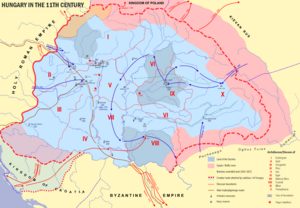
Coloman's father became king in 1074. When Géza died in 1077, Coloman and Álmos were still young. So, Géza's brother, Ladislaus I, became the new king. Ladislaus decided that Coloman should prepare for a life in the Church. This was unusual because Coloman was older than Álmos, and older brothers usually didn't become priests. An old book, the Illuminated Chronicle, describes Coloman as "of mean stature, but astute and quick of apprehension." It also says he was "shaggy and hirsute, half-blind and humpbacked." Some historians think his physical appearance might have influenced his uncle's decision. However, many modern experts believe this description might not be entirely true. It was written much later, during the rule of kings who were related to Álmos, Coloman's rival.
To prepare for his church career, Coloman learned to read and write. He became very good at Latin. Pope Urban II even praised his knowledge of church law in a letter. Historians believe he became a priest and then a bishop in the early 1090s. Old Hungarian stories say he was the bishop of either Eger or Várad.
In early 1095, Coloman and Álmos went with their uncle Ladislaus on a military trip. Before reaching the border, Ladislaus became very ill. He decided that Álmos would be his heir. Coloman did not agree and fled to Poland. He returned to Hungary around July 29, 1095, when his uncle died. How he became king is not fully clear. The Illuminated Chronicle says Ladislaus invited him back. It also says Álmos "honoured his brother, Coloman, and yielded to him the crown." This suggests a peaceful transfer of power. However, Coloman was crowned in early 1096, which was a delay. This might mean the brothers had some conflict before they agreed. It's also possible Coloman had to wait for the Pope to release him from his church vows before he could become king.
Dealing with Crusaders
Coloman was crowned in Székesfehérvár. At the same time, he gave the "dukedom with full rights" to his brother Álmos. This meant Álmos agreed to Coloman's rule in exchange for a large part of the kingdom.
Soon after his coronation, Coloman faced a big challenge: armies of the First Crusade passing through Hungary. Hungary had often provided food for pilgrims going to the Holy Land. But tens of thousands of crusaders moving through the country was a huge challenge.
The first group of crusaders, led by Walter Sans Avoir, arrived in May 1096. Coloman welcomed them and allowed them to buy food. They passed through Hungary mostly without problems. A small incident happened near Zimony (Zemun, Serbia), where some Hungarians attacked crusaders trying to buy weapons.
The next group, led by Peter the Hermit, arrived in late May or early June. Coloman let them in only after Peter promised they would not steal. But Peter's group did not keep their promise. They heard about the attack at Zimony and then attacked the town themselves. They killed many Hungarians before Coloman's troops arrived.
Another group of crusaders started robbing people near Nyitra (Nitra, Slovakia). Locals quickly defeated them. A fourth army came to Moson in June. Coloman did not let them leave the area, perhaps because he knew they caused trouble. These crusaders stole food and wine from nearby villages. Coloman decided to attack them. But his commanders convinced him to ask the crusaders to give up their weapons and money, promising them food. After they were disarmed, Coloman's troops attacked and killed them near Pannonhalma in early July.
[The crusaders] were even granted a licence to buy and sell necessary supplies... But when they were delayed there for some days, they began to wander... they violated the proclaimed peace, little by little stealing wine, barley, and other necessities from the Hungarians, finally seizing sheep and cattle in the fields and killing them...
Because of these problems, Coloman stopped a group led by Count Emicho from entering Hungary in July. But they broke through and attacked Moson. Coloman was worried they might take over the whole country. However, for some unknown reason, the attackers suddenly panicked and fled. This allowed the Hungarian defenders to defeat them. Many people at the time thought this defeat was a punishment from God because Emicho's group had killed many Jewish people.
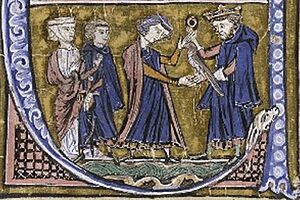
The main crusader army, led by Godfrey of Bouillon, arrived in September 1096. Godfrey sent a knight to negotiate with Coloman. Coloman agreed to let the crusaders pass through his kingdom. But he kept Godfrey's younger brother, Baldwin, and his family as hostages. The crusaders marched peacefully along the Danube river. Coloman and his army followed them. He released the hostages only after all the crusaders had crossed the Sava river, which was the southern border. This peaceful passage of the main crusader army made Coloman well-known and respected across Europe.
During this time, some Jewish people who were persecuted by crusaders in Bohemia came to Hungary. Coloman made laws, called Capitula de Iudeis, to manage their lives in Hungary. For example, he said they could not own Christian slaves. He also made laws to encourage his Muslim subjects to convert to Christianity. For instance, he ordered that if a Muslim had guests, they should only eat pork to prevent them from following their own dietary rules.
Expanding His Kingdom and Laws
Coloman changed Hungary's foreign policy. His uncle Ladislaus had supported the Holy Roman Emperor against the Pope. But Coloman, who had been a bishop, supported the Pope. This might have been influenced by his brother Álmos's close ties to the Emperor. In 1097, Coloman married Felicia, whose father, Roger I of Sicily, was a strong ally of the Pope.
In 1097, Coloman invaded Croatia. His uncle Ladislaus had already taken much of the country. But Petar Snačić, the last native Croatian king, was still fighting. Petar Snačić died fighting Coloman's army in the Battle of Gvozd Mountain. Hungarian troops reached the Adriatic Sea and took Biograd na Moru, an important port. The people of Trogir and Split asked the doge of Venice, Vitale Michiel, for help. Coloman, who had no navy, made an agreement with the doge in 1098. This agreement, called the Conventio Amicitiae, divided control: Hungary got the coastal parts of Croatia, and Venice got Dalmatia.
While Coloman was away, Álmos started planning against him. Coloman returned from Croatia and marched his army towards Álmos's duchy in 1098. The two armies met at Tiszavárkony, separated by the Tisza river. But the army commanders decided not to fight. They forced the king and the duke to make peace.
[Coloman] and his army marched to [Tiszavárkony] against [Álmos]... But loyal Hungarians sought to bring about a truce... they said: "Why do we fight? ... Let those two fight if fighting pleases them; and whichever of them shall win, let us take as lord."... they kept the peace, though it was not by their own will.
In 1099, Grand Prince Svyatopolk II of Kiev asked Coloman for help in a conflict. Coloman and his army crossed the Carpathian Mountains and attacked Peremyshl (Przemyśl, Poland). But an ally of the opposing prince, David Igorevich, convinced the Cumans to attack the Hungarians. Coloman's army was badly defeated. The Illuminated Chronicle says Hungarians rarely suffered such a great loss. Coloman barely escaped. Soon after, he met with Duke Bretislaus II of Bohemia and they renewed their friendship.
Around 1100, Coloman decided to review the laws of earlier kings. He admired Stephen I of Hungary, who had been made a saint. Coloman gathered his nobles and reviewed Stephen I's laws. They also passed new laws that made life easier for people and improved the economy. For example, one law said that strigae (vampires or evil spirits) "do not exist," and so people should not be persecuted for believing in them. Taxes on trade increased, showing that trade was growing. But he banned the export of Hungarian slaves and horses. Coins made during his reign were smaller to prevent people from cutting off their edges.
Coloman was crowned King of Croatia in Biograd na Moru in 1102. Some historians believe this union happened through conquest. However, a document from the late 14th century, called the Pacta conventa, says he was crowned only after making an agreement with twelve important Croatian nobles. This document is debated by scholars, but it suggests Croatia kept a special status. For example, Croatian nobles only had to fight for the king at their own expense up to the Drava river, which was seen as the border with Hungary.
Coloman was a man of warlike spirit, and resolved to subjugate to his lordship all the land to the Adriatic Sea. He came with a force of arms and took possession of the remaining part of Slavonia, which Ladislas had passed over.
To prevent an alliance between Coloman and Bohemond I of Antioch, the Byzantine Emperor Alexios I Komnenos arranged a marriage. His son, John, married Coloman's cousin, Piroska, in 1104 or 1105. This alliance helped Coloman invade Dalmatia in 1105. He personally led his troops to besiege Zadar, a major Dalmatian town. Zadar surrendered after its bishop helped negotiate a treaty. Other towns like Split, Trogir, and Šibenik also surrendered. A Hungarian fleet also took over islands in the Gulf of Kvarner. Coloman gave each Dalmatian town its own "charter of liberties." This meant citizens could elect their own bishops and were free from paying tribute to the king. After conquering Dalmatia, Coloman took a new title: "King of Hungary, Croatia and Dalmatia."
Family Challenges
Coloman had his four-year-old son, Stephen, crowned in 1105. This made Álmos openly rebel against the king. Álmos left Hungary and sought help from the Holy Roman Emperor, Henry IV. But the Emperor was having his own problems, so Álmos returned to Hungary in 1106. He then fled to his brother-in-law, Boleslaw III of Poland. With Polish help, he captured a fortress in Hungary. Coloman met with Boleslaw III, and they promised "perpetual friendship." Without Polish support, Álmos had to give in to Coloman.
In October 1106, Coloman's representatives told Pope Paschal II that the king would no longer choose church leaders in his lands. This was an important step for the Church. Historians believe this declaration helped the Pope recognize Coloman's control over Dalmatia. In 1107, Coloman helped his ally Boleslaw III of Poland defeat his brother. Coloman also sent Hungarian soldiers to help the Byzantine Emperor against Bohemond I of Antioch, who had invaded Byzantine lands. Bohemond was defeated and agreed to the Emperor's rule.
Around 1107 or 1108, Álmos went on a pilgrimage to the Holy Land. Coloman used this chance to take over Álmos's duchy. Álmos was allowed to keep his personal property, but Coloman now had full control over the kingdom. After returning, Álmos built a monastery at Dömös. During its dedication, where Coloman was present, Álmos was accused of trying to kill the king. Coloman had his brother arrested. But church leaders and other important people stepped in, and the king and his brother made peace.
Álmos then went to Passau to meet Henry V of Germany. At Álmos's request, Henry V invaded Hungary and attacked Pressburg (Bratislava, Slovakia) in September 1108. At the same time, Duke Svatopluk of Bohemia, who also supported Álmos, attacked areas north of the Danube. Coloman's ally, Boleslaw III, invaded Bohemia, forcing the Czech duke to retreat. The Emperor's attack on Pressburg failed. But he convinced Coloman to forgive Álmos, who was allowed to return to Hungary.
In the same year, Coloman visited Dalmatia and confirmed the special rights of Split, Trogir, and Zadar. He did this again in 1111. The Zobor Abbey received two grants from Coloman in 1111 and 1113. These documents suggest that Coloman may have established the bishopric at Nyitra (Nitra, Slovakia) between these years. The documents also mention a Mercurius as "princeps Ultrasilvanus", which might mean he was the first voivode of Transylvania. In 1112, Coloman attacked Austria, possibly to get revenge or simply to take goods.
In 1112, Coloman, whose first wife had died, married Euphemia of Kiev, a daughter of Vladimir Monomakh, Prince of Pereyaslavl. However, Coloman soon sent her back to her father.
Last Years and Legacy
In 1113, Duke Boleslaw III of Poland, who had blinded his rebellious brother, visited Hungary. He went on a pilgrimage to important religious sites, including the king's shrine at Székesfehérvár. Coloman welcomed him warmly. Shortly after this, between 1113 and 1115, Coloman found out that Álmos was again planning to take the throne. Coloman had Álmos and Álmos's young son, Béla, blinded. This was to make sure his own son would become king peacefully. The old stories say the child was thought to have died, but he was actually kept safe in a monastery for over ten years.
In August 1115, the fleet of Venice, led by Doge Ordelafo Faliero, invaded Dalmatia. The Venetians took some islands and coastal cities but could not take Zadar and Biograd na Moru. By this time, Coloman was very ill. Old records suggest he had a serious ear infection that affected his brain. Before he died, he told his son and nobles to get revenge on Russia for the defeat he suffered in 1099. On the advice of his helpers, he also had Álmos, who had taken refuge in a monastery, imprisoned.
The King now began to be gravely ill... This doctor applied a poultice to the ears of the King... and the strength of the poultice drew out through the cavities of his ears no small part of his brain... he showed it to Count Othmar... he said to the King: "Lord, it behoves you to prepare yourself for extreme unction".
Coloman died on February 3, 1116. The Illuminated Chronicle says he died early because of his "shedding of innocent blood" when he punished Álmos and Béla. He was the first king to be buried near the shrine of Stephen I in the Székesfehérvár Cathedral.
Family
| Ancestors of Coloman of Hungary | |||||||||||||||||||||||||||||||||||||||||||||||||||||||||||||||||||||||||||||||||||||||||||||||||||||||||||||||||||||||||||||||||||||||||||||||||||||||||||||||||||||||||||||||||||||||||||||||||||||||||||||||||||||||||||||||||||||||||||||||||||||||||||||||||||||||||||||||||||||||||||||||||||||||||||||||||||||||||||||||||||||||||||||||||||||||||||||||||||||||||||||||||||||||||||||||||||||||||||||||||||||||||||||||||||||||||||||||||||||||||||||||||||||||||||||||||||
|---|---|---|---|---|---|---|---|---|---|---|---|---|---|---|---|---|---|---|---|---|---|---|---|---|---|---|---|---|---|---|---|---|---|---|---|---|---|---|---|---|---|---|---|---|---|---|---|---|---|---|---|---|---|---|---|---|---|---|---|---|---|---|---|---|---|---|---|---|---|---|---|---|---|---|---|---|---|---|---|---|---|---|---|---|---|---|---|---|---|---|---|---|---|---|---|---|---|---|---|---|---|---|---|---|---|---|---|---|---|---|---|---|---|---|---|---|---|---|---|---|---|---|---|---|---|---|---|---|---|---|---|---|---|---|---|---|---|---|---|---|---|---|---|---|---|---|---|---|---|---|---|---|---|---|---|---|---|---|---|---|---|---|---|---|---|---|---|---|---|---|---|---|---|---|---|---|---|---|---|---|---|---|---|---|---|---|---|---|---|---|---|---|---|---|---|---|---|---|---|---|---|---|---|---|---|---|---|---|---|---|---|---|---|---|---|---|---|---|---|---|---|---|---|---|---|---|---|---|---|---|---|---|---|---|---|---|---|---|---|---|---|---|---|---|---|---|---|---|---|---|---|---|---|---|---|---|---|---|---|---|---|---|---|---|---|---|---|---|---|---|---|---|---|---|---|---|---|---|---|---|---|---|---|---|---|---|---|---|---|---|---|---|---|---|---|---|---|---|---|---|---|---|---|---|---|---|---|---|---|---|---|---|---|---|---|---|---|---|---|---|---|---|---|---|---|---|---|---|---|---|---|---|---|---|---|---|---|---|---|---|---|---|---|---|---|---|---|---|---|---|---|---|---|---|---|---|---|---|---|---|---|---|---|---|---|---|---|---|---|---|---|---|---|---|---|---|---|---|---|---|---|---|---|---|---|---|---|---|---|---|---|---|---|---|---|---|---|---|---|---|---|---|---|---|---|---|---|---|---|---|---|---|---|---|---|---|---|---|---|---|---|---|---|---|---|---|---|---|---|---|---|---|---|---|---|---|---|---|---|---|---|---|---|---|---|---|---|---|---|---|---|---|---|---|---|---|---|---|---|---|---|---|---|---|---|---|---|
|
|||||||||||||||||||||||||||||||||||||||||||||||||||||||||||||||||||||||||||||||||||||||||||||||||||||||||||||||||||||||||||||||||||||||||||||||||||||||||||||||||||||||||||||||||||||||||||||||||||||||||||||||||||||||||||||||||||||||||||||||||||||||||||||||||||||||||||||||||||||||||||||||||||||||||||||||||||||||||||||||||||||||||||||||||||||||||||||||||||||||||||||||||||||||||||||||||||||||||||||||||||||||||||||||||||||||||||||||||||||||||||||||||||||||||||||||||||
Coloman's first wife was Felicia, daughter of Count Roger I of Sicily. They married in the spring of 1097. She had at least three children: Sophia (born around 1100), and twin brothers Stephen and Ladislaus (born in 1101). Felicia and Ladislaus both died before Coloman.
Coloman's second wife was Eufemia, whom he married in the summer of 1112. She was born around 1096 or 1097, making her much younger than Coloman. She was the daughter of Vladimir II Monomakh, a prince from Kievan Rus'. Coloman soon sent her away. She later gave birth to a son named Boris, but Coloman's Hungarian family never accepted Boris as his son.
The family tree below shows Coloman's ancestors and some relatives mentioned in this article.
| Béla I | Richeza or Adelaide | ||||||||||||||||||||||||||||||||||||||||||||||||||||
| Sophia* | Géza I | unnamed Synadene* | Ladislaus I | ||||||||||||||||||||||||||||||||||||||||||||||||||
| Felicia of Sicily | Coloman | Eufemia of Kiev | Álmos | Piroska | John II Komnenos | ||||||||||||||||||||||||||||||||||||||||||||||||
| Sophia | Stephen II | Ladislaus | Kings of Hungary (from 1131) |
||||||||||||||||||||||||||||||||||||||||||||||||||
| Saul | |||||||||||||||||||||||||||||||||||||||||||||||||||||
*Whether Géza's first or second wife was his children's mother is uncertain.
His Legacy
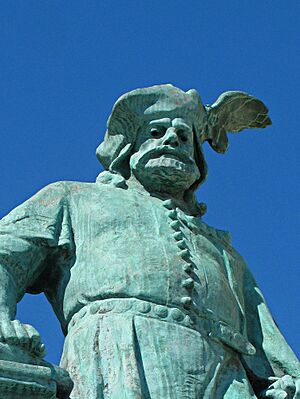
Later Hungarian stories, written by kings related to Álmos, often show Coloman in a negative light. The Illuminated Chronicle says many "evil things were done" during his rule. It even claims that the saintly Ladislaus I predicted Coloman "would shed blood." Modern historians believe this negative view was a form of "revenge" by Álmos's descendants. They wanted to highlight Coloman's failures and hide his successes.
However, earlier sources show a different picture. In 1105, a nunnery in Zadar stated that Coloman had brought back "peace of the land and the sea." A 13th-century writer, Roger of Torre Maggiore, even said Coloman was "inscribed in the catalogue of saints." Coloman's laws, which made Ladislaus I's harsh laws milder, also go against the idea of him being a bloodthirsty ruler. The introduction to his laws called him "the most Christian King Columban," who was "endowed with the artless grace of a dove and with all discernment of the virtues."
Historians today appreciate Coloman's skills as a leader. Many believe that under Coloman, the medieval Hungarian state became complete and took its final shape. His laws guided the kingdom for over a century, even under kings who disliked his memory. The small coins he introduced also set the standard for Hungarian money throughout the 12th century.
His contemporaries, Pope Urban II and Gallus Anonymus, knew about Coloman's "uncommon erudition" (great knowledge). The old stories say Hungarians called him Cunues or Qunwes—the Learned or the Book-Lover—"because of the books he owned." The Illuminated Chronicle says Coloman "read the canonical hours like a bishop" from his books. Historians think Coloman's royal court was a place of great learning and literature. Important historical writings were created during his time, including the Life of King Stephen of Hungary.


